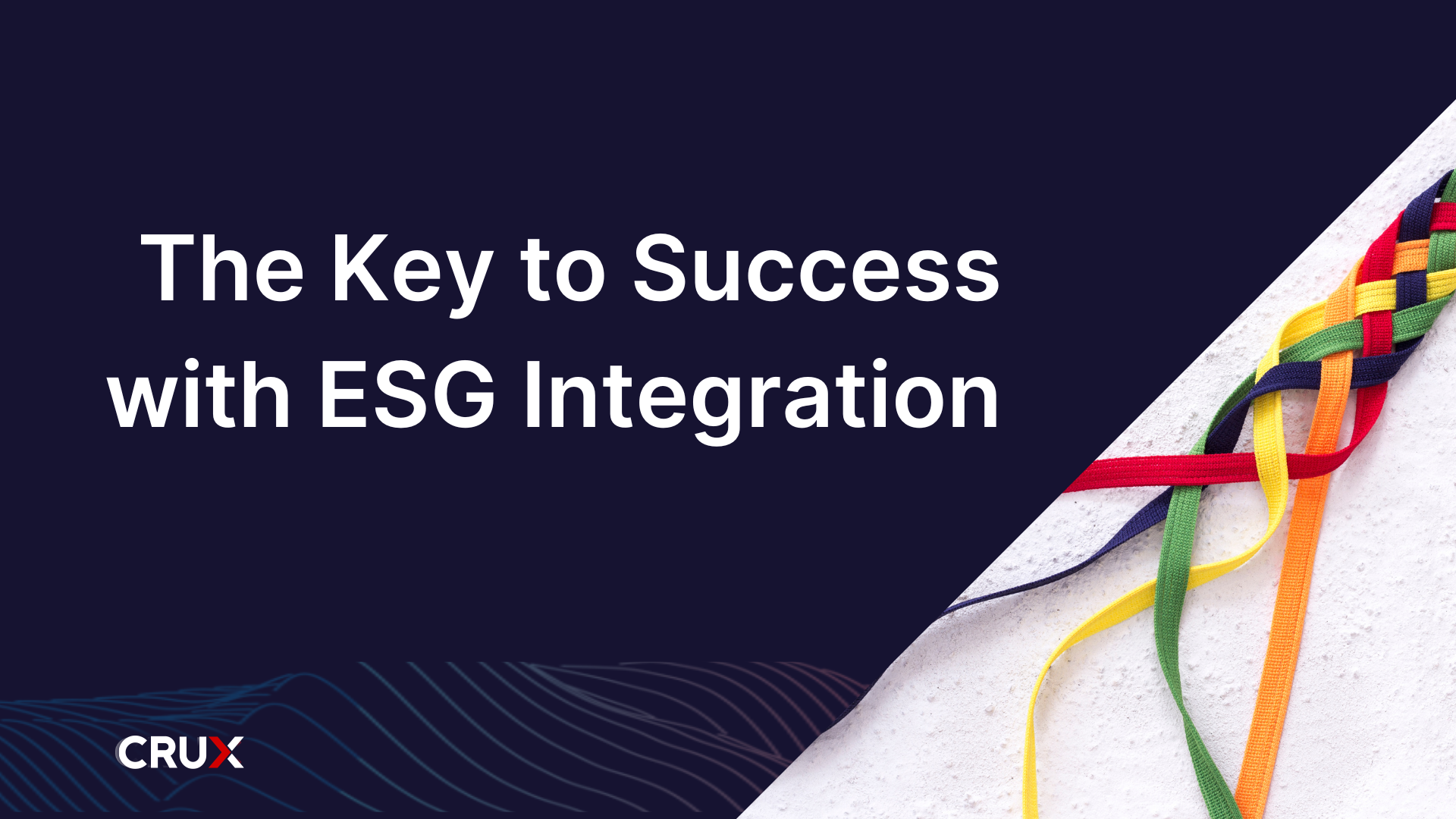Crux appoints industry veteran, naggi asmar as CTO
I recently had the opportunity to interview Naggi Asmar, Crux’s new Chief Technology Officer, and I was excited to learn more about his journey, his...
4 min read
![]() Jason Mendez
Nov 3, 2022
Jason Mendez
Nov 3, 2022

In a landscape full of variety and change, staying organized and on-target is the best way to benefit from ESG data integration.
You can’t look anywhere in the external data industry right now, from the government to private hedge funds, without hearing about ESG. It’s highly likely that you’re already integrating ESG data into your business operations or, at a minimum, keeping an eye on it as standards and regulations change.
In the US, earlier this month, President Biden signed an executive order on the data privacy agreement between the US and EU to protect the data rights of European citizens. New use cases continue to emerge, from water consumption to retail marketing. Some experts are even calling for a name change, all as CFOs and other leaders struggle to use such a challenging resource to deliver better returns.
It’s obvious that even in its ever-changing tumultuous state, ESG data is no longer something your business can avoid. So, where do you start?
The first step for getting started with ESG is to check your perspective. ESG is more than just a buzzword that every one of your competitors is using. You must clearly define its use cases, implementation requirements, plans for usage and maintenance, and a budget for your organization before touching any data. Once that’s clearly outlined, it’s time to jump slowly wade into the water–no jumping off a diving board straight into the deep end.
There are infinite use cases for ESG out there, and the data itself has so much variety as well. It’s both qualitative and quantitative. Does your company need self-reported data from its suppliers? Are you looking to monitor carbon emissions from yourself and the rest of your industry? Are you concerned about DEI and sentiment analysis from your employees and customers? The other side of that coin is understanding that this data also has its limitations.
As a beginner, it’s also helpful to give yourself some guardrails. There is data for anything you can imagine and use cases spontaneously appearing, but that doesn’t mean the solution for transforming that data into the proper use case answers is out there. Ingesting, transforming, and analyzing the data is a huge process and shouldn’t be underestimated.
Additionally, qualitative data can also be subjective, so there isn’t a one-size fits all solution to check the box for ESG data. A good example of this is your location. If you have two companies–one in New York and one in Texas–looking to understand and improve their DEI hiring metrics, the surrounding area’s demographic isn’t the same. This means it’s likely that DEI success in one location won’t be the same as the second because it’s subjective.
At the end of the day, technology can’t do it all…yet. The complexity of external data creates roadblocks to technological development, and a human touch is still needed. Getting the data ingested and ready for analysis is a ton of work, but so is applying the logic needed to glean insights from that information. With ESG data, there isn’t an off-the-shelf solution that delivers neatly wrapped answers.
Because ESG data ranges from standard to niche, the best idea is to start with core information suppliers and then determine what niche or specialty information is missing. With any of those providers, you should have a good understanding of what data they’re reporting, how it’s certified, where it comes from, how often it’s updated, and all from an independent perspective. You may also have to dive into understanding multiple rating systems, as each supplier is likely to have its own.
There are a core set of offerings from well-established data providers; this is always a common place to start. But as stated with ESG, it's important to have the requirements lined up first to help you traverse the nuances of ESG data.
For example, a company may have an acceptable rating itself, but are they customers of companies that make landmines? Have they merely outsourced their ESG flags to countries where the data is less transparent or verification more difficult? What about monitoring compliance and controversies as events happen? Most of the data in the world is still from the past. It needed to be reported, collected, cleaned, standardized, and delivered before it can be consumed. In this day and age, a simple tweet regarding a company's involvement with child labor, illegal fishing, or a host of other controversies can change the justification for an investment decision overnight.
All that said, there are several tried and true core ESG suppliers that provide a great place to start. Please note that this is not a comprehensive list of all the core ESG suppliers out there or even all the ESG suppliers Crux works with.
From there, you can spend time diving into their specific dataset descriptions and metadata information on what they offer and identify what gaps you need to fill with niche datasets to gain the insights your company needs.
Vendor management is a critical part of data management, and it’s often overlooked or pushed onto engineers as additional work. Datasets aren’t just used and discarded once–they require an ongoing relationship with the supplier for troubleshooting, licensing, and everything in between. Providing your data consumers with a qualified vendor manager will preemptively reduce their workload and provide a better overall experience for the entire organization.
Additionally, without a vendor manager who can define and follow an objective evaluation process for suppliers, most people will simply choose what they’re familiar with, whether it’s a supplier they’ve worked with before or one that their old colleague used five years ago and recommends. The ESG space is constantly changing as new suppliers, regulations, and standards alter the landscape on a daily basis. It’s critical to constantly re-evaluate, test old assumptions, and validate datasets to ensure you get the best possible data for your company. Hiring a vendor manager is the easiest way to keep the process objective and beneficial.
Utilizing ESG data for your critical business decisions is quickly becoming a necessity, not an option. It’s easy to quickly get overwhelmed by all the options and processes out there, but keeping your strategy front and center and working through the implementation process methodically and objectively is the best way to move forward and the quickest way to glean insights and reap the benefits of external data integration.
Still have questions? Send me an email, and I’ll be happy to help. If you’re looking for more information, check out this interview with MSCI’s Dania Koedih on all things ESG.

Jason is the Director of Supplier Strategy at Crux, focusing on strengthening our strategic supplier relationships and enriching the breadth of data available to our common customers. He has over two decades of experience in traditional financial data management covering strategic sourcing, financial and operational controls, budgeting, and vendor management. While off the clock Jason enjoys the Florida sun with his wife, six children, and new dog, George.

I recently had the opportunity to interview Naggi Asmar, Crux’s new Chief Technology Officer, and I was excited to learn more about his journey, his...

As 2024 draws to a close, the Crux Data team has been reflecting on the key trends shaping 2025. #1 out of them all? Operational Alpha.

Not long ago, we observed here in our blog that the critical insights that drive business value come from data that is both (1) fast and (2) reliable.